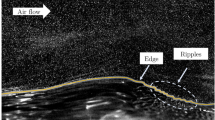Abstract
Aeromagnetic gradients are often used to enhance details or add new insights for interpretation. The gradients may be measured or derived from the total field or from transformation between horizontal and vertical gradients. At present, vertical, horizontal, and triaxial aeromagnetic gradiometers are in operation throughout the world, while the first two are used more widely. Transformations between horizontal and vertical gradients are needed for acquiring three gradient components or for checking the validity of measured gradients. Transformation of potential field by fast Fourier transform technique in frequency domain is popularly used; however, when applied to transforming between gradients, there is a problem that needs resolving. Because those expressions of transform operators are undefined when u or v is equal to zero or u and v are simultaneously equal to zero (u is the frequency in x-direction, and v is the frequency in y-direction), the operators cannot be sampled at these frequencies. Consequently, the transformation cannot be implemented by fast Fourier transform technique directly. In this article, shift sampling theory is employed for resolving this problem. Model test results show that the technique has good accuracy, and the real case of transformation indicates that the computed results agree better with the measured gradients; it demonstrates not only the effectiveness of method but also the reliability of the measured gradients.
Similar content being viewed by others
References Cited
Chai, Y. P., 1997. Shift Sampling Theory and Its Application. Petroleum Industry Press, Beijing (in Chinese with English Abstract)
Chai, Y. P., 1996. Shift Sampling Theory for Numerical Computation of Fourier Transform. Science in China (Series E), 26(5): 450–456 (in Chinese)
Chai, Y. P., 1988. Algorithm Investigation of DFT of Potential Field. Chinese Journal of Geophysics, 31(2): 211–223 (in Chinese with English Abstract)
Chai, Y. P., Hinze, W. J., 1988. Gravity Inversion of an Interface above Which the Density Contrast Varies Exponentially with Depth. Geophysics, 53(6): 837–845
Chai, Y. P., Jia, J. J., 1998. Application of Shift Sampling Theory to Magnetic Anomaly Reduction-to-the-Pole. Oil Geophysical Prospecting, 33(4): 486–495 (in Chinese with English Abstract)
Cowan, D. R., Baigent, M., Cowan, S., 1995. Aeromagnetic Gradiometers—A Perspective. Exploration Geophysics, 26: 241–246
Dean, W., 1958. Frequency Analysis for Gravity and Magnetic Interpretation. Geophysics, 23(1): 97–127
Doll, W. E., Gamey, T. J., Beard, L. P., et al., 2006. Airborne Vertical Magnetic Gradient for Near-Surface Applications. The Leading Edge, 1: 50–53
Guan, Z. N., Hao, T. Y., Yao, C. L., 2002. Prospect of Gravity and Magnetic Exploration in the 21st Century. Progress in Geophysics, 17(2): 237–244 (in Chinese with English Abstract)
Guan, Z. N., Hou, J. S., Yao, C. L., 1996. Application of Aeromagnetic of Gradient Data in Geological Mapping and Metallogenetic Prognosis of Gold Deposits. Geoscience, 10(2): 239–248 (in Chinese with English Abstract)
Gunn, P. J., 1975. Linear Transformations of Gravity and Magnetic Fields. Geophysical Prospecting, 23(2): 300–312 (in Chinese with English Abstract)
Guo, Z. H., 2004. The Practical Improvement of Forward and Inversion Technique on Aeromagnetic Gradient Data and Its Application: [Dissertation]. China University of Geosciences, Beijing (in Chinese with English Abstract)
Hou, Z. C., 1979. Establish an Interpretation System for Gravity and Magnetic Survey by Potential Transform. Geophysical & Geochemical Exploration, 3: 1–10 (in Chinese)
Jin, X. L., 2004. The Development of Technique of Marine Geophysics. Journal of East China Institute of Technology, 27(1): 6–13 (in Chinese with English Abstract)
Li, X. L., Cai, W. L., 2006. The Assembly and Compensation of the Aeromagnetic Gradiometic System on Y-5 Aircraft. Geophysical & Geochemical Exploration, 30(3): 224–232 (in Chinese with English Abstract)
Luo, Y., Li, X. L., Cai, W. L., et al., 2007. Preliminary Analysis of Aeromagnetic Gradient Experimental Flight Data in Chaoshui Basin. Journal of East China Institute of Technology, 30(2): 164–170 (in Chinese with English Abstract)
Mushayandebvu, M. F., Davies, J., 2006. Magnetic Gradients in Sedimentary Basins: Examples from the Western Canada Sedimentary Basin. The Leading Edge, 1: 69–73
Nabighian, M. N., 1984. Toward a Three-Dimensional Automatic Interpretation of Potential Data via Generalized Hilbert Transforms: Fundamental Relations. Geophysics, 49(6): 780–786
Nabighian, M. N., Grauch, V. J. S., Hansen, R. O., et al., 2005. The Historical Development of the Magnetic Method in Exploration. Geophysics, 70(6): 33ND–61ND
Nelson, J. B., 1994. Leveling Total-Field Aeromagnetic Data with Measured Horizontal Gradients. Geophysics, 59(8):1166–1170
Nelson, J. B., 1988. Calculation of the Magnetic Gradient Tensor from Total Field Gradient Measurements and Its Application to Geophysical Interpretation. Geophysics, 53(7):957–966
Nelson, J. B., 1986. An Alternate Derivation of the Three-Dimensional Hilbert Transform Relations from First Principles. Geophysics, 51(4): 1014–1015
Oruç, B., Keskinsezer, A., 2008. Detection of Causative Bodies by Normalized Full Gradient of Aeromagnetic Anomalies from East Marmara Region, NW Turkey. Journal of Applied Geophysics, 65: 39–49
Paterson, N. R., Reevesj, C. V., 1985. Applications of Gravity and Magnetic Surveys: The State-of-the-Art in 1985. Geophysics, 50(12): 2558–2594
Scott Hogg, R. L., 2004. Practicalities, Pitfalls and New Developments in Airborne Magnetic Gradiometry. Annual Meeting of the Prospectors & Developers Association of Canada, Toronto, Canada
Shearer, S., Li, Y., 2004. 3D Inversion of Magnetic Total Gradient Data in the Presence of Remanent Magnetization. 74th Annual Meeting, SEG, Technical Program Expanded Abstracts, 23: 774–777
Zhang, C. D., 2006. Airborne Tensor Magnetic Gradiometry—The Latest Progress of Airborne Magnetometric Technology. Chinese Journal of Engineering Geophysics, 3(5): 354–361 (in Chinese)
Zhang, H. R., Fan, Z. G., 2007. Recent Advances in Aerogeophysical Techniques Used Abroad. Geophysical & Geochemical Exploration, 31(1): 1–8 (in Chinese with English Abstract)
Author information
Authors and Affiliations
Corresponding author
Additional information
This study was supported by China Aero Geophysical Survey & Remote Sensing Center for Land & Resources (863 Program, No. 2006AA06A201).
Rights and permissions
About this article
Cite this article
Li, H., Xu, S., Yu, H. et al. Transformations between aeromagnetic gradients in frequency domain. J. Earth Sci. 21, 114–122 (2010). https://doi.org/10.1007/s12583-010-0003-6
Received:
Accepted:
Published:
Issue Date:
DOI: https://doi.org/10.1007/s12583-010-0003-6




